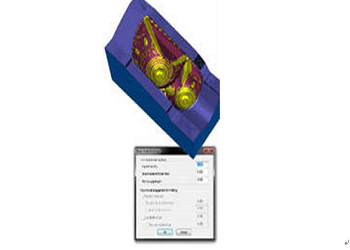
The 2013 R2 version of Delcam’s FeatureCAM feature-based CAM software incorporates a number of new stock model options that allow users to increase productivity, improve surface finish and reduce tool wear. Other enhancements in this release include new methods for the generation of html set-up sheets, and improvements to turning and turn-mill programming.
For full details, including video demonstrations of the new functionality, please go to www.delcam.tv/fc2013/lz/en/whats-new-videos-r2.html
FeatureCAM was the world’s first feature-based programming software when it was launched in 1995. Constant development since then has ensured that the system has retained its leadership in programming speed and ease of use, while an increased range of strategies has been added to provide more efficient toolpaths giving greater productivity on a wider range of machines.
The first addition to the stock model functionality eliminates excessive tool engagement and limits the maximum depth of any cut into un-machined material. Both these controls reduce tool wear and improve surface finish by avoiding any overloading of the tool. They can be used on both stock models imported into FeatureCAM, such as castings that need some finish machining, or on the stock models generated by FeatureCAM after each machining operation. The same functionality also removes toolpath segments that machine very little or no material.
Rest machining has been made more efficient in two ways. Firstly, a new “detect metal thicker” command ensures that rest material thinner than the specified limit is ignored. This prevents toolpaths being generated in any areas where the benefit of the extra cut is negligible, such as cusps left by the previous toolpath.
Secondly, toolpath fragmentation and the resultant air moves between fragments can be reduced by specifying a minimum gap length between cutting moves. Any gaps shorter than the specified distance will be linked with a tangential move between the segments, rather than having the tool retract fully from the surface for a very short air move.
FeatureCAM 2013 R2 also incorporates a new method for generating html set-up sheets. Information can be extracted from the FeatureCAM project to provide a detailed list of the tooling to be used, with an illustration of each tool, together with the dimensions of the initial stock and an image of the finished part.
A number of turning improvements have also been implemented, including smoother lead-in and lead-out moves that reduce any witness marks when finishing larger turned parts in a number of sections, and the ability to specify the optimum retract angle for turn-grooving operations and so leave a better surface finish on the part.
Turn-mill operations have been made more efficient by offering an alternative method for calculating the index limits. This calculates the limits based on the size of a solid revolve of the part, rather than creating a cylinder around the corner limits of a rectangular bounding box around the part stock. The new method can give an index distance closer to the part shape and so produce more efficient toolpaths.
Finally, a new add-in has been made available for easier programming of barrel-cam features. This uses the slot centreline and follower diameter to create a four-axis milling feature and produces a toolpath with a tool of the chosen diameter that may be smaller than the follower. When the feature is wrapped around the X-axis of the part, small moves in the Y-axis can be used in conjunction with adjustments to the A-axis to ensure that the walls of the slot are machined correctly. |